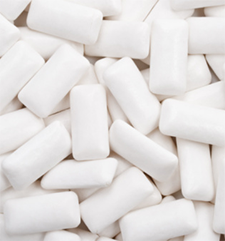
Need help whitening your teeth? Want to quit smoking? Trying to lose weight? There’s a chewing gum for all of that and more. New types of chewing gum are introduced all the time, but did you ever wonder how it managed to gain such a grip on consumers? Believe it or not, people have had a love affair with gum for thousands of years. From humble beginnings to hundreds of varieties, here’s a look at how chewing gum rose to become the powerhouse product it is today.
How It Originated
Long before William Wrigley Jr. made a name for chewing gum, ancient civilizations were tapping into trees and other sources of resin and chewing on soft, rubbery substances both for enjoyment and medicinal purposes. Evidence indicates prehistoric Europeans would chew on birch bark tar quite possibly to help relieve toothaches, while Aztecs and Mayans would turn to gum from the chicle tree to appease their thirst or hunger. In North America, Native Americans favored spruce tree resin, and it became commercialized and sold in sticks by a colonist named John Bacon Curtis in 1848.
Eventually, scientist Thomas Adams succeeded in enhancing chicle with flavor, and his work would set off various trials to improve the ability to retain flavor – with peppermint found to be particularly effective. Mr. Adams helped bring attention to chewing gum by introducing it to vending machines and selling it in the subways of New York in 1888, but chewing gum really took off when a soap industrialist named William Wrigley Jr. promoted it as an add-on to his products. From “Juicy Fruit” to “Doublemint” gum, Wrigley created one of the most successful chewing gum companies that ever existed, and many of his products remain popular today.
Gum Gets a Modern Makeover
After the turn of the century, chewing gum innovations accelerated due to deeper research and newfound discoveries. Bubble gum and other sweet flavors became a mainstay, and production further proliferated in the 1930’s and 1940’s, when synthetic rubbers made mass production easier than ever. Perhaps one of the biggest advancements came in the 1950’s, when sugarless chewing gum was first created by a dentist, Dr. Petrulis, and sold to William Wrigley Jr. The nation was becoming more health-conscious, and chewing gum products followed suit.
Today, chewing gum comes in countless varieties, and has grown even more popular due to its ability to:
Freshen breath: almost all types of gum come flavored to help mask odors
Keep teeth white: both chewing and active ingredients can fight tooth staining
Fight plaque: sugar free, xylitol-based gum inhibits the growth of oral bacteria
Aid in weight loss: many turn to gum as a low calorie treat instead of snacking
Help quit smoking: nicotine gum is an effective substitute for cigarettes
Supplement your diet: certain gums are fortified with vitamins and minerals
Several sugarless brands also come with a seal of approval from the American Dental Association, and are recommended by dentists to help fight tooth decay.
Choosing the Right Gum
Chewing gum is often purchased on impulse, but putting a little thought into the type of gum you choose can make a big difference to your oral health. Read the labels closely to ensure you have selected a sugarless variety that won’t harm your teeth, and then narrow down the field based on additional preferences – from flavor to active ingredients and beyond. If you need help in choosing the right gum, or are unsure about the effectiveness of a particular brand you have chosen, simply call your dentist for guidance. Just like most things, chewing gum should be done in moderation since chewing gum too frequently may lead to jaw muscle fatigue or more serious issues such as Temporomandibular Joint Disorders (TMD).
Sources:
Chewing Gum. (n.d.) Retrieved July 28, 2015, from http://www.madehow.com/Volume-1/Chewing-Gum.html
History of Chewing Gum. (n.d.) Retrieved July 17, 2015, from http://www.chewinggumfacts.com/chewing-gum-history/history-of-chewing-gum/
Nix, Elizabeth. (2015, February 13). Chew on This: The History of Gum. Retrieved July 21, 2015, from http://www.history.com/news/hungry-history/chew-on-this-the-history-of-gum

